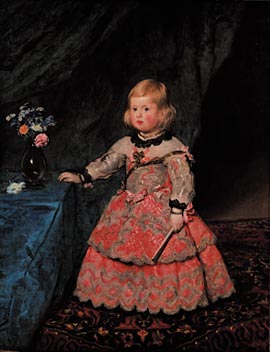 |
 |
 |
 |
 |
|
| Diego Rodríguez de Silva y Velázquez Infanta Margarita Teresa in a Pink Gown, 1654 Oil on canvas, 128.5 x 100 cm Kunsthistorisches Museum, Gemäldegalerie, Vienna 321 |
||
Margarita Teresa (1651–73) was the first-born child of King Philip IV of Spain and his second wife Maria Anna of Austria. Philip had been a widower since 1644. Two years later, after the premature death of the Infante Balthasar Carlos, the king's only son and heir to the throne, he decided to remarry. His bride-to-be, the young Archduchess Maria Anna, had previously been engaged to Balthasar Carlos. She was the daughter of Philip's sister Maria with the Emperor Ferdinand III and therefore his niece. In October 1649, the fourteen-year-old was married to the Spanish king per procuram in Vienna. Shortly thereafter, she traveled via Trento and Milan to Madrid. For generations, the dynastic connection between the Spanish and Austrian lines of the Hapsburgs was constantly being renewed through marriage, with the political aim to strengthen the alliance between the Emperor and the King of Spain against France. In 1648, the Peace of Westphalia had concluded the Thirty Years' War, but Spain and France remained at war for eleven more years until the Peace of the Pyrenees in 1659. Included in the terms of the treaty was a marriage contract between Louis XIV, later the King of France, and Maria Teresa, the eldest daughter of Philip IV. The wedding ceremonies were organized by the Marshal of the Palace (aposentador del palacio), Diego Velázquez. Margarita Teresa had been promised at an early age to the future Emperor Leopold I. Five portraits of the Infanta by Velázquez are known. The painting shown here is the earliest, usually dated 1653 or 1654. The recent discovery of letters exchanged between Emperor Ferdinand III and his brother-in-law Philip IV allow us to limit the possible period of creation even further. On September 29, 1652 Ferdinand III requested for the first time a portrait of the young Infanta, and he repeated his wish more than a year later, on January 1, 1654: El retrato de mi nieta aguardaré a su comodo. (I expect the portrait of my niece at your convenience.) On October 8 of the same year, the emperor acknowledged the delivery of the painting: Me he holgado mucho con el retrato de mi nieta, que Dios la guarde, es lindísima. (I was very pleased with the portrait of my niece, may God bless her. It is very delightful.) The next installment, Infanta Margarita Teresa in a White Dress (1656), echoes the sitter's semblance in the contemporaneous Las Meninas (Madrid, Museo del Prado). In 1659, reports Velázquez's first biographer Palomino, Infanta Margarita Teresa in a Blue Dress and a portrait of her younger brother, the Infante Felipe Próspero, were painted and sent to the court in Vienna. At age fifteen, Margarita Teresa arrived in the imperial city. On December 12, 1666 she was married to the monarch to whom she had been promised from childhood. She gave birth to four children (only one survived) and died in 1673 at age twenty-two. Infanta Margarita Teresa in a Pink Gown is one of Velázquez's most enchanting infant portraits. Margarita Teresa stands on a red and black patterned carpet draped over a low pedestal. She wears an ornate pink and silver brocade dress with a black lace collar, a golden necklace, bracelets and a golden chain across her chest. Her hairstyle is simple, as befits her age. The vase of glass on the table, accentuated by sparse, but highly descriptive brushstrokes, is especially delicate and far ahead of its time in terms of its impressionistic treatment. It contains roses, irises, and marguerites—perhaps an allusion to the sitter's name. Velázquez's artistic virtuosity, which has been defined as a combination of a sure eye and a swift hand, breathed new life into the long stagnant convention of the court portrait. Without offending his patrons or the formal etiquette obligatory for this format, he captured the child's naive charm in a timeless manner that resonates with the viewer even today. The Fundación Casa de Alba, Madrid, has a second version of the portrait without the vase. Art historians regard it either as a preliminary study for the work discussed here, painted from life by the master himself, or as a copy by Mazo. —Karl Schütz |